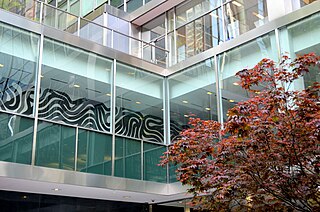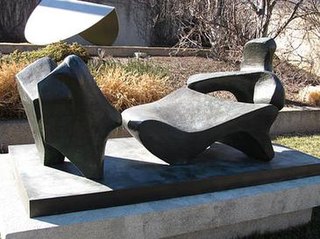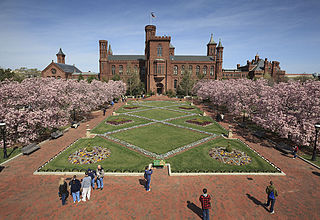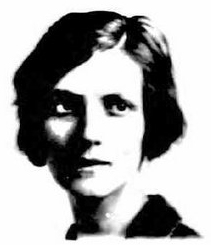
Gordon Bunshaft,, was an American architect, a leading proponent of modern design in the mid-twentieth century. A partner in Skidmore, Owings & Merrill (SOM), Bunshaft joined the firm in 1937 and remained with it for more than 40 years. His notable buildings include Lever House in New York, the Beinecke Rare Book and Manuscript Library at Yale University, the Hirshhorn Museum and Sculpture Garden in Washington, D.C., the National Commercial Bank in Jeddah, Saudi Arabia, 140 Broadway, and Manufacturers Hanover Trust Branch Bank in New York.

The Hirshhorn Museum and Sculpture Garden is an art museum beside the National Mall in Washington, D.C., United States. The museum was initially endowed during the 1960s with the permanent art collection of Joseph H. Hirshhorn. It was designed by architect Gordon Bunshaft and is part of the Smithsonian Institution. It was conceived as the United States' museum of contemporary and modern art and currently focuses its collection-building and exhibition-planning mainly on the post–World War II period, with particular emphasis on art made during the last 50 years.

Robert Gober is an American sculptor. His work is often related to domestic and familiar objects such as sinks, doors, and legs.

Sam Gilliam was an American color field painter and lyrical abstractionist artist. Gilliam was associated with the Washington Color School, a group of Washington, D.C.-area artists that developed a form of abstract art from color field painting in the 1950s and 1960s. His works have also been described as belonging to abstract expressionism and lyrical abstraction. He worked on stretched, draped and wrapped canvas, and added sculptural 3D elements. He was recognized as the first artist to introduce the idea of a draped, painted canvas hanging without stretcher bars around 1965. This was a major contribution to the Color Field School and has had a lasting impact on the contemporary art canon. Arne Glimcher, Gilliam's art dealer at Pace Gallery, wrote following his death that "His experiments with color and surface are right up there with the achievements of Rothko and Pollock."

Joseph Herman Hirshhorn was an entrepreneur, financier, and art collector.

Throwback is a public artwork by American artist Tony Smith, located at the Hirshhorn Museum and Sculpture Garden in Washington, D.C., United States. This version is the third of an edition of three in the series with one artist's proof.

Antipodes is a public artwork by American sculptor Jim Sanborn located outside of the Hirshhorn Museum and Sculpture Garden in Washington, DC, United States.

Are Years What? is a sculpture by American artist Mark di Suvero. It is in the collection of the Hirshhorn Museum and Sculpture Garden, in Washington, D.C., United States. The sculpture is named after poet Marianne Moore's "What Are Years". From May 22, 2013 through May 26, 2014, the sculpture resided temporarily in San Francisco, as part of the San Francisco Museum of Modern Art's Mark di Suvero exhibition at Crissy Field.

Agricola I is a 1952 abstract sculpture by American artist David Smith. The artwork is located on the grounds at and in the collection of the Hirshhorn Museum and Sculpture Garden in Washington, D.C., United States. The word "agricola" means "farmer" in Latin. This work is the first in the Agricola series by Smith.

Three-Piece Reclining Figure No. 2: Bridge Prop is a sculpture by Henry Moore, created in 1963, and produced in an edition of six copies.

Lunar Bird is an abstract bronze sculpture by Joan Miró. It was modeled in 1945, enlarged in 1966, and cast in 1967.

Draped Reclining Figure, 1952–53 is a bronze sculpture by Henry Moore, catalogued as "LH 336".

The Smithsonian Gardens, a division of the Smithsonian Institution, is responsible for the "landscapes, interiorscapes, and horticulture-related collections and exhibits", which serve as an outdoor extension of the Smithsonian's museums and learning spaces in Washington, D.C. Established in 1972 as a groundskeeping and horticulture program, Smithsonian Gardens currently manages 180 acres of gardens on the National Mall, 64,000 square feet of greenhouse production space, and the Archives of American Gardens, a research collection of over 60,000 photographs and archival records covering American landscape history from the 1870s to the present.

Spatial Concept: Nature is a series of bronze sculptures by Lucio Fontana designed between 1959 and 1960. A series of these sculptures cast in 1965 is installed at the Hirshhorn Museum and Sculpture Garden in Washington, D.C., and a set cast in 1961 is owned by the Walker Art Center and installed in the Minneapolis Sculpture Garden.
Young Girl on a Chair is a 1955 bronze sculpture by Giacomo Manzù, installed at the Hirshhorn Museum and Sculpture Garden in Washington, D.C. The work measures 45 by 23+3⁄8 by 43+3⁄4 inches and depicts a nude young girl with her arms rested in her lap.

Monumental Head is a 1960 bronze sculpture by Alberto Giacometti, installed at the Hirshhorn Museum and Sculpture Garden in Washington, D.C., in the United States. The abstract work measures 37 x 11 3/4 x 14 3/4 inches and depicts a roughly modeled head with an extended neck. Other casts of Monumental Head from this period are found in the collections of other institutions, including the Phillips Collection and the Los Angeles County Museum of Art.

Alice Acheson was an American painter and printmaker.
Maggie Michael is an American painter. Born in Milwaukee, Michael has spent much of her career in Washington, D.C. A 1996 graduate of the University of Wisconsin-Milwaukee, from which she received a BFA, with honors, she received her MA from San Francisco State University in 2000 and her MFA from American University in 2002. She has received numerous awards during her career, including a grant from the Joan Mitchell Foundation in 2004, the same year in which she was given a Young Artist Grant by the D.C. Commission on the Arts and Humanities; she has also worked with the Hirshhorn Museum and Sculpture Garden. Michael is married to the sculptor Dan Steinhilber. She has served on the faculty of the Corcoran College of Art and Design.
Untitled is a 1986 stainless steel sculpture by Ellsworth Kelly, installed at the Hirshhorn Museum and Sculpture Garden, in Washington, D.C., United States. The sculpture measures 78 inches (200 cm) x 135.25 inches (343.5 cm) x 129.75 inches (329.6 cm).















